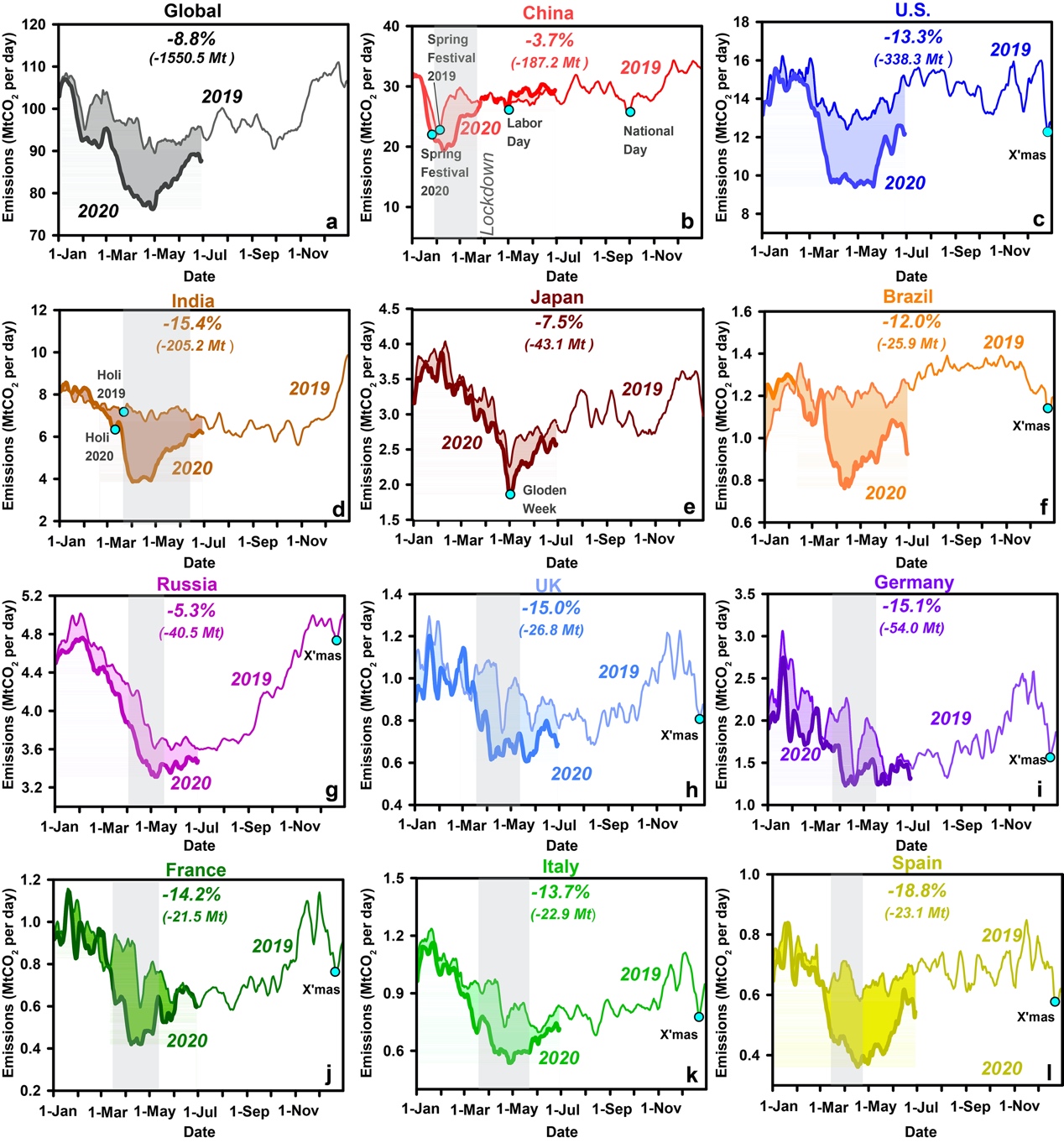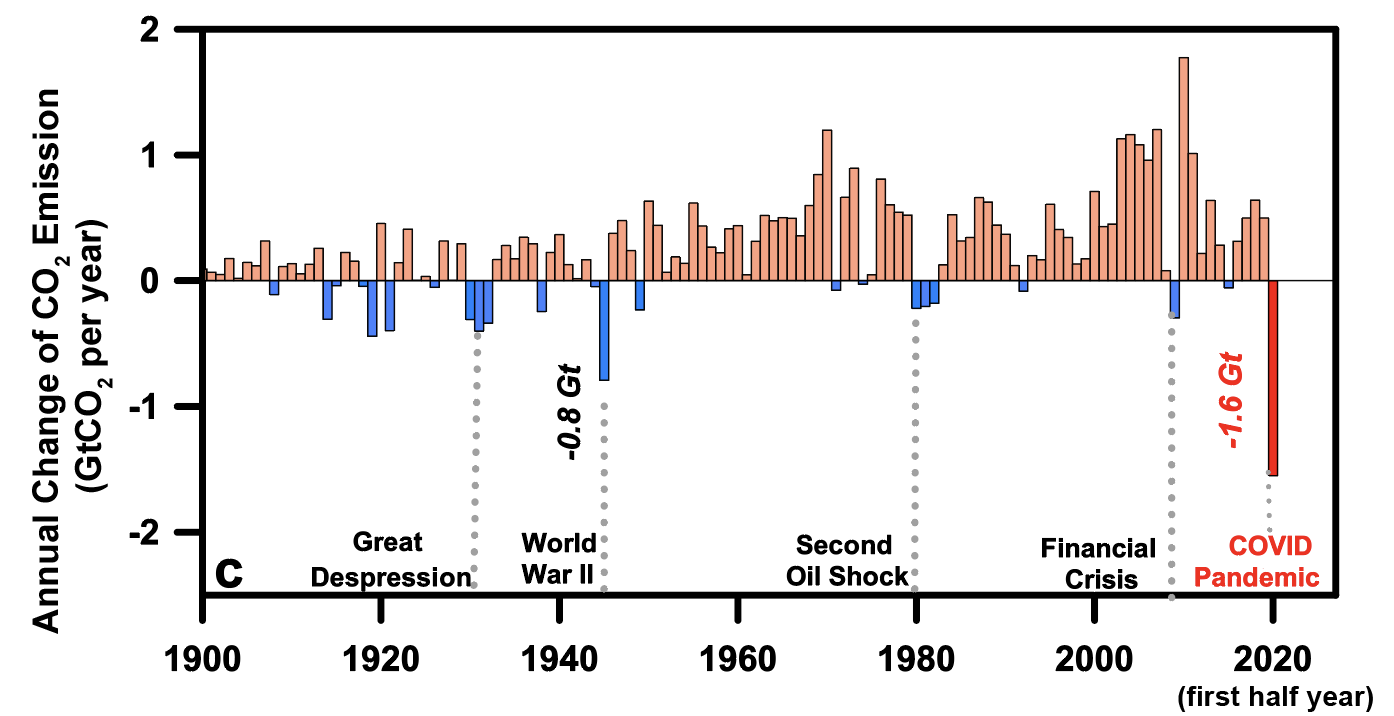Responding to climate change and fighting the COVID-19 pandemic is a major challenge for the sustainable development of mankind. CO2 emissions from the burning of fossil energy by humans are the most important driving factor for climate change. With the global outbreak of the COVID-19 pandemic, human activities have shown a trend of large-scale reduction. Industrial production and energy consumption in some countries and regions have dropped by nearly 30%, which has an impact on global energy use and CO2 emissions.
In order to reflect the changes in global CO2 emissions after the COVID-19 pandemic timely, the research group of Associate Professor Liu Zhu from the Department of Earth System Science (DESS) of Tsinghua University has joined 27 domestic and foreign institutions to observe the changes in the intensity of human activities based on multi-sectoral high-temporal-resolution data to construct a global first near-real-time CO2 emission database, and revealed that the COVID-19 pandemic has caused the largest reduction in CO2 emissions from human activities in history, and its short-term decline exceeds that during the Second World War and the 2008 financial crisis. Through the near-real-time monitoring of carbon emissions from human activities, it is possible to greatly shorten the response time of emission reduction policy adjustments, and provide scientific support for the global "green recovery" in the post-pandemic era. The research results were published in the high-impact scientific journal Nature Communications under the title of Near-real-time monitoring of global CO2 emissions reveals the effects of the COVID-19 pandemic.

Figure 1 Global and major countries' CO2 emissions trends from 2019 to the first half of 2020
The research is constructed by analyzing near real-time data such as electricity production in 31 countries around the world, traffic congestion index in 416 major cities, flight data, industrial production in 62 countries, and population-weighted global surface temperature in 206 countries. The actual daily CO2 emissions data of major countries in the world from 2019 to the present in the fields of electricity, industry, ground transportation, aviation, international shipping, and residential consumption was constructed.
Studies have shown that in the first half of 2020, the global CO2 emissions from human activities will be reduced by 1.55 billion tons, and a drop of 8.8% compared to the same period in 2019, which is more than that during the Second World War and the 2008 financial crisis. In terms of different sectors, the transportation sector has seen the largest changes in CO2 emissions due to various travel restrictions. Among them, the ground transportation sector has the largest emission reduction, with a relative decrease of 610 million tons of CO2 emissions, accounting for 40% of the total emission reduction in the first half of 2020; the aviation sector has the largest reduction in emission reductions, with international aviation emissions down 52.4%, and domestic aviation Emissions fell by 35.8% compared to the same period in 2019.

Figure 2 COVID-19 causes the largest annual decrease of CO2 emission since 1900
Studies have shown that since the emergence of the COVID-19 pandemic on a global scale in mid-March 2020, CO2 emissions in various countries have been affected to varying degrees. In June 2020, the epidemic situation was controlled to a certain extent, and the social and economic activities and carbon emissions of various countries began to gradually recover. However, because the United States, Brazil, India and other countries have not adopted effective prevention and control measures, the decline in CO2 emissions from human activities in June 2020 will still remain above 10%.
Based on near-real-time activity and emissions data, the study estimates that global CO2 emissions will be reduced by 8.8% in the first half of 2020, reflecting the unprecedented impact of the epidemic on the global economy. Although the COVID-19 pandemic has caused a record reduction in CO2 emissions, to achieve economic recovery from the epidemic, carbon-intensive measures cannot be completely relied on, otherwise global CO2 emissions will likely rebound and exceed pre-pandemic levels. Therefore, in order to achieve a "green recovery" after the epidemic (both economic recovery, but also to promote the realization of climate goals), and structural changes must be monitored as soon as possible to identify and correct inefficient strategies. The global real-time carbon database established in this study will help to manage carbon emissions more flexibly and in a timely manner, shorten the response time for policy adjustments, and provide references and references for global scientific researchers and policy makers.
Associate Professor Liu Zhu, China Emission Accounts and Datasets (CEADs) and DESS of Tsinghua University, is the first and corresponding author of the paper, academician of the French Academy of Sciences, Professor Philippe Ciais of the French Laboratory of Environmental and Climate Sciences, and Deng Zhu, a doctoral student in DESS, Tsinghua University, is the co-first author of the article. The research was supported by the National Natural Science Foundation of China, Beijing Natural Science Foundation and Qiushi Foundation. Relevant research data are published on the Carbon Monitor website (http://carbonmonitor.org).
Full text link: https://www.nature.com/articles/s41467-020-18922-7/
Writers: Deng Zhu
Reviewers: Wu Haiping
Editor: Wang Jiayin